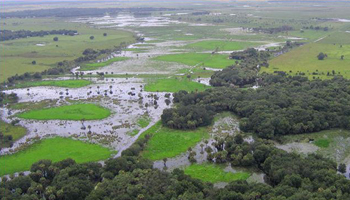
Unusually heavy rain in 2013 produced discharges of poor quality, fresh water from Lake Okeechobee into the coastal estuaries, resulting in large losses of marine life, as well as dramatic visible contrasts in the Indian River Lagoon. Photo courtesy Congressman P. Murphy.
In response to a state legislative request, Florida Sea Grant director Karl Havens and colleagues at the University of Florida recently completed an assessment of freshwater management policies and activities that adversely affect coastal environments on the both the east and west coasts of Florida.
The team’s report highlights options that federal and state agencies can follow to reduce damaging freshwater outflow from Lake Okeechobee to the St. Lucie and Caloosahatchee estuaries, and direct it instead to the southern Everglades.
The discharge of water to the ocean, a consequence of flood control and water delivery systems designed many decades ago for agriculture and the burgeoning population of South Florida, is widely recognized to have caused considerable injury to natural ecosystems of the St. Lucie Estuary, the Caloosahatchee Estuary, Lake Okeechobee, and the Florida Everglades.

To reduce the amount of contaminants entering Lake Okeechobee, managers work with private land owners to store excess stormwater, reducing pollutants that eventually enter the coastal estuaries. Photo courtesy S. Fla. Water Mgt. District.
Despite challenges, the report’s authors conclude that solutions to the damaging discharges could be found “using existing technology,” but that the path forward would require large land acquisitions and water storage projects that are not currently planned.
Already underway in the region is the massive Comprehensive Everglades Restoration Plan, an overhaul of water management projects for central and southern Florida that’s expected to take 30 years. Known as CERP, the plan aims to re-engineer water systems so they capture excessive fresh water that now flows primarily east and west from Lake Okeechobee to the coast. The water would be re-directed south to water-starved parts of the Everglades, and to boost municipal drinking water supplies.
In 2013, however, public outcry arose over the release of especially high volumes of poor quality, fresh water that negatively impacted salinity levels and water quality in sensitive estuaries along both Florida coasts. The releases were necessary, according to water managers, to control flooding caused by an above average rainy season.
Concerns about the timing and completion of the Everglades Restoration moved legislators to investigate whether more immediate solutions could be found to take pressure off the estuaries. They asked the University of Florida team to provide an independent assessment of existing plans.
“The solution is enormous increases in storage and treatment of water both north and south of the lake. Existing and currently authorized storage and treatment projects are insufficient to achieve these goals,” the report stated.

The Port Mayaca lock and dam is just one of a complex series of installations that manage discharges of fresh water from Lake Okeechobee into the St. Lucie Estuary. Photo courtesy S. Fla. Water Mgt. District.
As an example, the team of authors found that that an estimated 200,000 acre-ft of storage is required in the St. Lucie River watershed, part of the larger Indian River Lagoon system. However, only one 40,000 acre-ft storage reservoir is under construction. In the Caloosahatchee River watershed, the report estimates that 400,000 acre-ft of storage is needed, but at present, one 170,000-acre-ft reservoir has been designed, but not yet funded. A large amount of new storage is needed north and south of the lake, but it is not planned for at this time by the state.
The authors also identify five options to reduce the amount of water flowing to the estuaries and to move more water south from Lake Okeechobee:
- Accelerate funding and completion of existing approved projects designed specifically to provide relief to the St. Lucie and Caloosahatchee basins.
- Provide water storage and treatment north of Lake Okeechobee, including the acquisition of additional land north of the lake.
- Provide additional water storage, treatment and conveyance south of Lake Okeechobee.
- Explore the construction of a system of large, subterranean injection wells to capture excess flows.
- Implement a substantial revision to the current schedule of regulatory releases from Lake Okeechobee, one that would “require balancing benefits of holding additional water in the lake for the express purpose of reducing damaging discharges to the estuaries and increasing agricultural, urban and ecosystem water supply versus potential adverse impacts to the lake’s ecology.”
Additional authors on the report are Wendy Graham, director of the UF Water Institute; Thomas Frazer, director of the UF School of Natural Resources; Peter Frederick, a researcher in the department of wildlife ecology; Ramesh Reddy, the chair of the department of soil and water science; and Mary Jane Angelo, director of the environmental and land-use law program at UF’s Levin College of Law.
The full report can be accessed from the Florida Senate at this link. An executive summary is provided in the publication.



